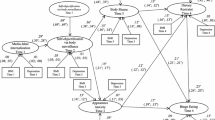Abstract
Objective
Eating disorders, including obesity, are a major public health problem today. Throughout history, body image has been determined by various factors, including politics and media. Exposure to mass media (television, movies, magazines, Internet) is correlated with obesity and negative body image which may lead to disordered eating. The authors attempt to explain the historical context of the problem and explore potential avenues for change.
Method
The authors review changes in ideal female body type throughout history, comment on current attitudes toward shape and weight in both men and women and outline interventions aimed at increasing healthy habits and fostering self-esteem in youth.
Results
Throughout history, the ideal of beauty has been difficult to achieve and has been shaped by social context. Current mass media is ubiquitous and powerful, leading to increased body dissatisfaction among both men and women.
Conclusion
Parents need to limit children’s exposure to media, promote healthy eating and moderate physical activity and encourage participation in activities that increase mastery and self-esteem. Funding for high-quality, visible advertising campaigns promoting healthy life styles may increase awareness.
Similar content being viewed by others
References
American Obesity Association (AOA) Obesity in the U.S.; Overall Prevalence. Accessed on January 30, 2006. Available at http://www.obesity.org/
Gentil DA, Oberg C, Sherwood NE, et al: Well child visits in the video age: pediatricians and the American Academy of Pediatrics’ guidelines for children’s media use. Pediatrics 2004; 114: 1235–1241
Borzekowski DL, Bayer AM: Body image and media use among adolescents. Adolesc Med 2005; 16: 289–313
Braun DL, Sunday SR, Huang A, et al: More males seek treatment for eating disorders. Int J Eat Disord 1999; 25: 415–124
Field AE, Carmargo CA, Taylor CB, et al: Peer, parent, and media influences on the development and frequent dieting among preadolescent and adolescent girls and boys. Pediatrics 2001; 107: 54–60
Thesander M: The Feminine Ideal. London, Reaktion Books, 1997
Fallon P: Feminist Perspectives on Eating Disorders. New York, Guilford Press, 1994
Anderson BS, Zinsser JP. A History of Their Own: Women in Europe from Prehistory to the Present. New York: Oxford University Press, Inc, 1999
Brumberg JJ: The Body Project: An Intimate History of American Girls. New York, Random House, 1997
Brownell KD, Napolitano MA: Distorting reality for children: body size proportions of Barbie and Ken dolls. Int J Eat Dis 1995; 18: 295–298
Wallace A: Jamie Lee Curtis: true thighs. More 2002
Kilbourne J: Deadly persuasion: Why Women Must Fight the Addictive Power of Advertising. New York: Free Press, 1999
Pipher M: Hunger Pains: The Modern Woman’s Tragic Quest for Thinness. New York, Ballantine Books, 1995
Becker AE, Burwell RA, Gilman SE, et al: Eating behaviours and attitudes following prolonged exposure to television among ethnic Fijian adolescent girls. Br J Psychiatry 2002; 180: 509–514
Becker AE, Hamburg P: Culture, media, and the eating disorders. Harvard Rev Psychiatry 1996; 4: 163–167
Fleming-Morn M, Thiagarajah K: Behavioral interventions and the role of television in the growing epidemic of adolescent obesity—data from the 2001 youth risk behavioral survey. Methods Inf Med 2005; 44: 303–309
Tiggeman M, Pickering AS: Role of television in adolescent women’s body dissatisfaction and drive for thinness. Int J Eat Disord 1996; 20: 199–203
Hill AJ, Draper E, Stack J: A weight on children’s minds: body shape dissatisfaction at 9 years old. Int J Obes 1994; 18: 383–389
Tyre P: Fighting anorexia: no one to blame. Newsweek, 2005
Andrist LC: Media images, body dissatisfaction, and disordered eating in adolescent women. MCN Am J Matern Child Nurs 2003; 28: 119–123
Caralat DJ, Camargo CA, Herzog DB: Eating disorders in males: a report on 135 patients. Am J Psychiatry 1997; 154: 1127–1132
Woodside DB, Garfinkel PE, Lin E, et al: Comparisons of men with full or partial eating disorders, men without eating disorders. Am J Psychiatry 2001; 158: 570–574
Duggan SJ, McCreary DR: Body image, eating disorders, and the drive for muscularity in gay and heterosexual men: the influence of media images. J Homosex 2004; 47(3—4): 45–58
Pope HG Jr, Olivarda R, Gruber A, et al: Evolving ideals of male body image as seen through action toys. Int J Eat Dis 1999; 26: 65–72
Pope HG Jr, Phillips KA, Olivarda R: The Adonis Complex. New York, Free Press, 2000
Brink PJ, Ferguson K: The decision to lose weight. West J Nurs Res 1998; 20: 84–102
Levy AS, Heaton AW: Weight control practices of US adults trying to lose weight. Ann Intern Med 1993; 119: 661–666
Riess H, Dockray-Miller M: Integrative Group Treatment for Bulimia Nervosa. New York, Columbia University Press, 2002
Burt JV, Hertzler AA: Parental influence on the child’s food preference. J Nutr Educ 1978; 10: 127–130
Davison KK, Birch LL: Weight status, parent reaction, and self-concept in five-year-old girls. Pediatrics 2001; 107: 46–53
Zametkin AJ, Koon CK, Klein HW, et al: Psychiatric aspects of child and adolescent obesity: a review of the past ten years. J Am Acad Child Adolesc Psychiatry 2004; 43: 134–150
Elliot DL, Goldberg L, Moe EL, et al: Preventing substance abuse and disordered eating: initial outcomes of the ATHENA (Athletes Targeting Healthy Exercise and Nutrition Alternatives) program. Arch Pediatr Adolesc Med 2004; 158: 1043–1049
Neumark-Sztainer D: Addressing obesity and other weight-related problems in youth. Arch Pediatr Adolesc Med 2005; 159: 290–291
Author information
Authors and Affiliations
Corresponding author
Rights and permissions
About this article
Cite this article
Derenne, J.L., Beresin, E.V. Body Image, Media, and Eating Disorders. Acad Psychiatry 30, 257–261 (2006). https://doi.org/10.1176/appi.ap.30.3.257
Published:
Issue Date:
DOI: https://doi.org/10.1176/appi.ap.30.3.257




